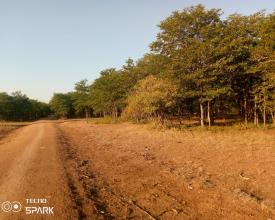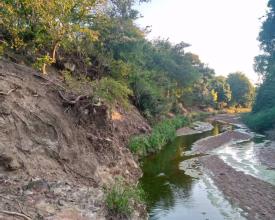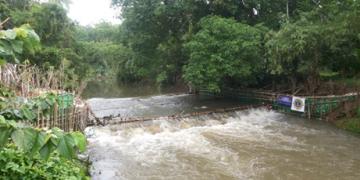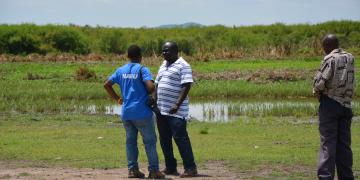
CHIEFS FOR CHANGE: TRADITIONAL LEADERSHIP CHAMPIONING FOREST AND LANDSCAPE RESTORATION
Since 2010, communities in Senior Group Village Headman Bande, under Traditional Authority Mbenje in Nsanje, have taken bold steps to regenerate their degraded forests and restore the surrounding landscape. This initiative followed years of widespread deforestation that began in the mid-1990s, when residents turned to charcoal production and brick curing—activities heavily reliant on firewood—as primary sources of income. This unsustainable exploitation of natural resources led to the loss of community forests and the clearing of vital tree cover along the Lalanje River. Over time, the landscape was stripped bare, and the Lalanje River, once the area's most crucial water source, dried up in the early 2000s, flowing only during the rainy season. The community’s efforts mark a critical turning point in reversing environmental damage and restoring the health of their ecosystem.
Contexto
Défis à relever
The initiative in Bande Village addresses key environmental, social, and economic challenges. Environmentally, the lack of affordable, clean energy sources like gas or solar forces communities to rely on firewood, leading to deforestation and degradation of the Lalanje River and surrounding landscape. Socially, communities face capacity gaps in managing forest resources, including water harvesting, tree propagation, and monitoring forest cover, due to limited skills and equipment. Economically, poverty remains a major driver of forest destruction, as residents turn to charcoal production and firewood sales for income. To address this, the project promotes sustainable alternatives like beekeeping and other income-generating activities that reduce reliance on forests. These efforts aim to restore ecosystems while empowering communities with better livelihoods and skills, helping to break the cycle of poverty and environmental degradation.
Ubicación
Procesar
Summary of the process
The four building blocks work together to create a strong, community-owned foundation for forest and landscape restoration. Customary leadership serves as the entry point, anchoring restoration efforts in local authority and cultural legitimacy. This leadership drives the creation and enforcement of community bylaws, which provide a clear framework for regulating resource use and protecting regenerating forests. Inclusive dialogue and participatory decision-makingensure that all community voices—especially women and youth—are heard, building collective ownership and compliance with the bylaws. Finally, partnerships that bridge policy and tradition link these local actions to broader government and NGO support, enabling scale and sustainability. Each element reinforces the others: traditional leaders give legitimacy, bylaws create structure, dialogue fosters buy-in, and partnerships open doors for resources and policy influence—together delivering lasting restoration impact.
Building Blocks
Customary Leadership as Environmental Stewards
Traditional leaders play a central role in forest governance, using their authority to mobilize communities, enforce local bylaws, and protect communal natural resources. Their deep-rooted influence ensures that restoration efforts are respected, locally appropriate, and sustained over time. By recognizing chiefs as key custodians of land, the initiative bridges tradition with environmental management, creating a strong foundation for long-term forest and landscape restoration.
Community Bylaws for Sustainable Resource Use
One of the most effective tools introduced is the development of community-based bylaws, led and endorsed by traditional leaders. These rules regulate tree cutting, grazing, and charcoal burning while promoting natural regeneration and reforestation. When integrated with traditional authority, these bylaws gain legitimacy, making enforcement more effective and aligning customary systems with environmental sustainability.
Inclusive Dialogue and Participatory Decision-Making
Restoration efforts are built on trust and local ownership. Chiefs facilitate inclusive dialogue, bringing together elders, women, youth, and farmers to discuss land use and conservation priorities. This participatory approach ensures that solutions reflect the community’s realities, increases buy-in, and strengthens collective action for protecting forests and degraded landscapes.
Bridging Policy and Tradition through Partnerships
Working with traditional authorities creates a pathway for aligning customary practices with national forest policies. Partnerships with government, NGOs, and local councils help translate grassroots action into policy influence and unlock resources for scaling. Chiefs become powerful allies not only in enforcement but also in advocating for sustainable land use at district and national levels.
Impacts
Since 2010, the most visible impact in GVH Bande has been the successful regeneration of thousands of indigenous trees and natural forests. The village now stands as the first and only one in Malawi with extensive forest cover growing freely, without pressure from surrounding communities. This regeneration has also revived the once-dry Lalanje River and led to the return of wildlife, including monkeys, antelopes, and snakes—marking a strong comeback of biodiversity in the area.
Access to firewood, the main cooking fuel, has greatly improved thanks to the enforcement of community bylaws and strong voluntary participation. This has eased the burden on women, who no longer need to travel long distances to collect firewood or water. As a result, domestic tensions have reduced, allowing women more time with their families and enabling greater involvement in community life.
Importantly, these changes have created new economic opportunities. With more time available, many women have joined irrigation clubs to diversify their incomes, while others have launched small-scale businesses to support their households. Overall, the regeneration efforts have not only restored ecosystems and wildlife but also strengthened social cohesion and improved livelihoods—demonstrating a powerful, people-led model for environmental recovery.
Beneficiaries
Women now access water and firewood nearby; men use river water for livestock and irrigation. Brickmakers benefit from forest wood, while the whole community enjoys cooler, milder weather.
Global Biodiversity Framework (GBF)
Sustainable Development Goals
Story
From Devastation to Regeneration
During the Mozambican civil war, many Mozambicans sought refuge across the border in Malawi, arriving in Nsanje District under Traditional Authority Mbenje. The people of GVH Bande welcomed them with open arms, offering land and shelter during a time of great need. But as the refugee population grew, so did the pressure on local resources. What began as an act of humanity slowly evolved into an environmental and social crisis.
The newcomers introduced charcoal production as a livelihood, using indigenous trees to produce charcoal for sale in urban areas. This practice quickly spread across the host communities. By the early 2000s, GVH Bande had lost nearly all its forest and riverbank cover. Trees that once stood tall along the mighty Lalanje River were reduced to ash, and the river itself—a lifeline for the community—dried up, only flowing during the rainy season. The consequences were stark: water scarcity, loss of firewood, declining soil fertility, disappearing wildlife, and diminishing livelihoods.
Concerned by the rapid destruction, the then village chief and his council decided to act. With technical guidance from the Department of Forestry, they drafted and enacted community bylaws in 2010 to govern the use and protection of forest resources. The community committed to natural regeneration practices, allowing tree stumps and roots to regrow, and banning illegal tree cutting. Slowly, the landscape began to change.
Today, the transformation is remarkable. Indigenous trees have returned, and the Lalanje River now flows year-round. The village has regained a reliable water source for drinking, irrigation, and livestock. Firewood is once again accessible within the community, easing the burden on women and reducing conflicts in households. The regenerated forest also supports local economies: residents now use sustainably sourced wood for building and brick curing under strict development oversight.
What was once a barren, drying landscape is now a thriving, biodiverse environment. Wildlife such as fish, monkeys, and antelope have reappeared. The community enjoys milder weather—an unusual but welcome change in hot, dry Nsanje. Women have more time to engage in economic activities, and men use the restored river for agriculture and livestock.
The natural regeneration strategy in GVH Bande is more than a conservation success; it’s a story of resilience, leadership, and community-driven change. Thanks to the for








